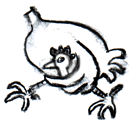CyberHand
The Cyberhand Project - www.cyberhand.org
From their website:
From their website:
The main objectives of the CYBERHAND Project are to increase the basic knowledge of neural regeneration, and sensory-motor control of the hand in humans and to exploit this knowledge to develop a new kind of hand prosthesis which will overcome some of the drawbacks of current systems. This new prosthesis will:
- be felt by an amputee as the lost natural limb delivering her/him a natural sensory feedback by means of the stimulation of some specific afferent nerves;
- be controlled in a very natural way by processing the efferent neural signals coming from the central nervous system (reducing the discomfort of the current EMG-based control prosthesis).



